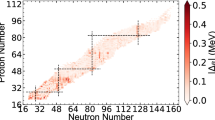Abstract
Our knowledge of the properties of dense nuclear matter is usually obtained indirectly via nuclear experiments, astrophysical observations, and nuclear theory calculations. Advancing our understanding of the nuclear equation of state (EOS, which is one of the most important properties and of central interest in nuclear physics) has relied on various data produced from experiments and calculations. We review how machine learning is revolutionizing the way we extract EOS from these data, and summarize the challenges and opportunities that come with the use of machine learning.

Similar content being viewed by others
References
C. Drischler, J. Holt, and C. Wellenhofer, Chiral effective field theory and the high-density nuclear equation of state, Annu. Rev. Nucl. Part. Sci. 71(1), 403 (2021)
B. A. Li, L. W. Chen, and C. M. Ko, Recent progress and new challenges in isospin physics with heavy-ion reactions, Phys. Rep. 464(4–6), 113 (2008)
M. Oertel, M. Hempel, T. Klähn, and S. Typel, Equations of state for supernovae and compact stars, Rev. Mod. Phys. 89(1), 015007 (2017)
A. Sorensen, K. Agarwal, K. W. Brown, et al., Dense nuclear matter equation of state from heavy-ion collisions, ar**v: 2301.13253 (2023)
J. Lattimer, Neutron stars and the nuclear matter equation of state, Annu. Rev. Nucl. Part. Sci. 71(1), 433 (2021)
J. A. López, C. O. Dorso, and G. A. Frank, Properties of nuclear pastas, Front. Phys. (Bei**g) 16(2), 24301 (2021)
M. Tsang, J. Stone, F. Camera, P. Danielewicz, S. Gandolfi, K. Hebeler, C. J. Horowitz, J. Lee, W. G. Lynch, Z. Kohley, R. Lemmon, P. Möller, T. Murakami, S. Riordan, X. Roca-Maza, F. Sammarruca, A. W. Steiner, I. Vidaña, and S. J. Yennello, Constraints on the symmetry energy and neutron skins from experiments and theory, Phys. Rev. C 86(1), 015803 (2012)
H. Wolter, M. Colonna, D. Cozma, et al., Transport model comparison studies of intermediate-energy heavy-ion collisions, Prog. Part. Nucl. Phys. 125, 103962 (2022)
Y. J. Wang and Q. F. Li, Application of microscopic transport model in the study of nuclear equation of state from heavy ion collisions at intermediate energies, Front. Phys. (Bei**g) 15(4), 44302 (2020)
M. I. Jordan and T. M. Mitchell, Machine learning: Trends, perspectives, and prospects, Science 349(6245), 255 (2015)
G. Carleo, I. Cirac, K. Cranmer, L. Daudet, M. Schuld, N. Tishby, L. Vogt-Maranto, and L. Zdeborová, Machine learning and the physical sciences, Rev. Mod. Phys. 91(4), 045002 (2019)
A. J. Hey, S. Tansley, K. M. Tolle, et al., The Fourth Paradigm: Data-Intensive Scientific Discovery, Vol. 1, Microsoft Research Redmond, WA, 2009
S. Gazula, J. Clark, and H. Bohr, Learning and prediction of nuclear stability by neural networks, Nucl. Phys. A. 540(1–2), 1 (1992)
S. Bass, A. Bischoff, C. Hartnack, J. A. Maruhn, J. Reinhardt, H. Stocker, and W. Greiner, Neural networks for impact parameter determination, J. Phys. G Nucl. Part. Phys. 20(1), L21 (1994)
P. Bedaque, A. Boehnlein, M. Cromaz, M. Diefenthaler, L. Elouadrhiri, T. Horn, M. Kuchera, D. Lawrence, D. Lee, S. Lidia, R. McKeown, W. Melnitchouk, W. Nazarewicz, K. Orginos, Y. Roblin, M. Scott Smith, M. Schram, and X. N. Wang, A. I. for nuclear physics, Eur. Phys. J. A 57(3), 100 (2021)
A. Boehnlein, M. Diefenthaler, N. Sato, M. Schram, V. Ziegler, C. Fanelli, M. Hjorth-Jensen, T. Horn, M. P. Kuchera, D. Lee, W. Nazarewicz, P. Ostroumov, K. Orginos, A. Poon, X. N. Wang, A. Scheinker, M. S. Smith, and L. G. Pang, Colloquium: Machine learning in nuclear physics, Rev. Mod. Phys. 94(3), 031003 (2022)
W. B. He, Y. G. Ma, L. G. Pang, H. C. Song, and K. Zhou, High energy nuclear physics meets Machine Learning, ar**v: 2303.06752 (2023)
W. He, Q. Li, Y. Ma, Z. M. Niu, J. C. Pei, and Y. X. Zhang, Machine learning in nuclear physics at low and intermediate energies, ar**v: 2301.06396 (2023)
P. Morfouace, C. Tsang, Y. Zhang, W. G. Lynch, M. B. Tsang, D. D. S. Coupland, M. Youngs, Z. Chajecki, M. A. Famiano, T. K. Ghosh, G. Jhang, J. Lee, H. Liu, A. Sanetullaev, R. Showalter, and J. Winkelbauer, Constraining the symmetry energy with heavy-ion collisions and Bayesian analyses, Phys. Lett. B 799, 135045 (2019)
M. O. Kuttan, J. Steinheimer, K. Zhou, and H. Stoecker, The QCD EoS of dense nuclear matter from Bayesian analysis of heavy ion collision data, ar**v: 2211.11670 (2022)
B. A. Li and W. J. **e, Bayesian inference of in-medium baryon–baryon scattering cross sections from HADES proton flow data, ar**v: 2303.10474 (2023)
S. Huth, P. T. Pang, I. Tews, T. Dietrich, A. Le Fèvre, A. Schwenk, W. Trautmann, K. Agarwal, M. Bulla, M. W. Coughlin, and C. Van Den Broeck, Constraining neutron-star matter with microscopic and macroscopic collisions, Nature 606(7913), 276 (2022)
L. G. Pang, K. Zhou, N. Su, H. Petersen, H. Stöcker, and X. N. Wang, An equation-of-state-meter of quantum chromodynamics transition from deep learning, Nat. Commun. 9(1), 210 (2018)
Y. Wang, Z. Gao, H. Lü, and Q. Li, Decoding the nuclear symmetry energy event-by-event in heavy-ion collisions with machine learning, Phys. Lett. B 835, 137508 (2022)
K. Zhou, L. Wang, L. G. Pang, and S. Z. Shi, Exploring QCD matter in extreme conditions with Machine Learning, ar**v: 2303.15136 (2023)
M. Raissi, P. Perdikaris, and G. E. Karniadakis, Physics-informed neural networks: A deep learning framework for solving forward and inverse problems involving nonlinear partial differential equations, J. Comput. Phys. 378, 686 (2019)
Acknowledgements
The work was supported in part by the National Natural Science Foundation of China (Grant Nos. U2032145 and 11875125) and the National Key Research and Development Program of China (Grant No. 2020YFE0202002).
Author information
Authors and Affiliations
Corresponding author
Additional information
Declarations
The authors declare that they have no competing interests and there are no conflicts.
Rights and permissions
About this article
Cite this article
Wang, Y., Li, Q. Machine learning transforms the inference of the nuclear equation of state. Front. Phys. 18, 64402 (2023). https://doi.org/10.1007/s11467-023-1313-3
Received:
Accepted:
Published:
DOI: https://doi.org/10.1007/s11467-023-1313-3




